The Grand Canyon is an extensive plateau and river valley region characterized by steep and deep canyons carved over millions of years by the Colorado River in northern Arizona, southwestern United States. It consists predominantly of sedimentary rocks in horizontal layers. Considered a "geological library", the Grand Canyon is one of the most studied landscapes in the world, being one of the places with the best examples of erosion of arid terrain and observation of stratified layers.
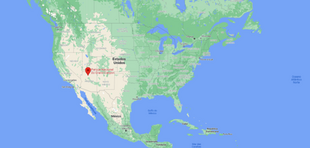
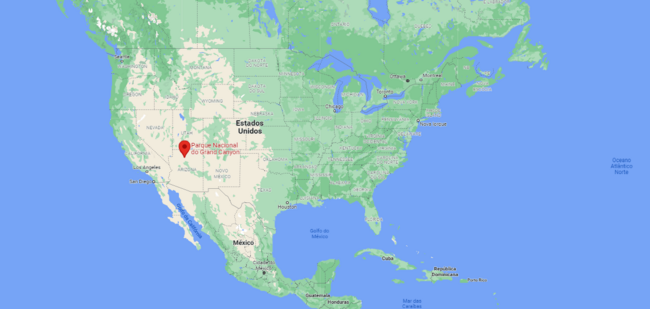


The region constitutes the Grand Canyon National Park, characterized by:
- It has been a UNESCO World Heritage Site since 1979 and covers an area of 1,218,375 hectares on the Colorado Plateau in northwestern Arizona.
- The region is semi-arid and consists of high plateaus and basins typical of the southwestern United States.
- Drainage systems have cut deeply into the rocks, forming numerous steep-walled canyons.
- Forests are found at higher elevations, while the lower elevations are composed of a series of desert basins.
The canyon is exceptionally large, ranging in width from about 160 m to 29 km and extending in a winding course from the mouth of the Paria River in northern Arizona to near the Nevada state line, an incredible distance of about 446 km. The canyons reach depths of up to 1.8 km. Hence its name: the Grand Canyon!
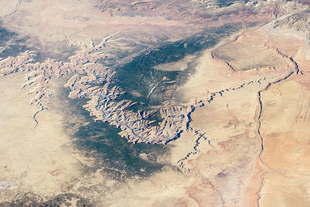
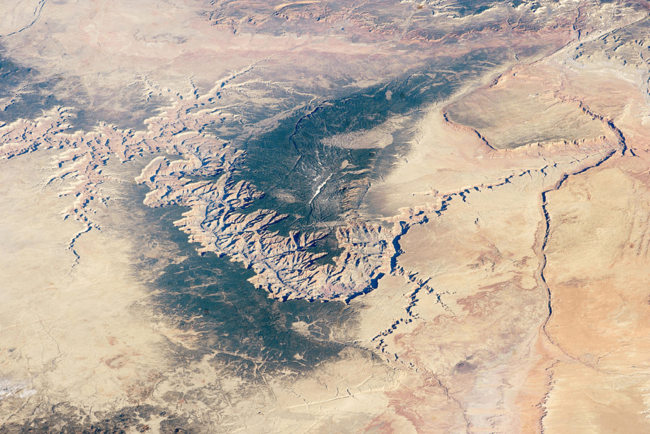


The Grand Canyon has immense geological importance:
- Provides an excellent record of approximately 2 billion years of Earth's history
- It presents a rich and diverse fossil record that reveals the history of life on Earth
- It presents a wide range of geological features and rock types, and numerous caves containing extensive and significant geological, paleontological, archaeological and biological resources.
There is no other place on Earth where the pages of geologic history can be read so directly to reveal the events recorded in its layers. In addition to geology, the Grand Canyon contains several important ecosystems.
It is also notable for being an ecological haven, with relatively intact remnants of declining ecosystems (such as boreal forest and desert riparian communities). It is home to numerous rare, endemic (found only in the Grand Canyon), and specially protected (threatened or endangered) species of plants and animals.
How was the Grand Canyon formed? What types of rocks make it up?
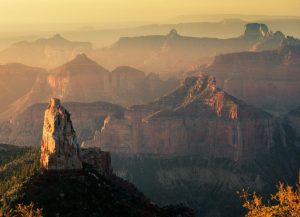



The geological events that formed the Grand Canyon can be summarized as:
- Formation of igneous, metamorphic and sedimentary rocks at the base of the canyon, approximately 2 billion years ago, spanning the Proterozoic Eon
- Deposition of sediments that will generate the layers of sedimentary rocks that span the Paleozoic Era and locally, the Mesozoic Era
- Uplift of rocks associated with the collision of tectonic plates, generating the Colorado Plateau, about 60 million years ago
- Erosive processes by the Colorado River, carving the rocks and forming the canyon, about 5 million years ago to the present day
The rocks of the Grand Canyon can be divided into three packages:
- The oldest crystalline basement rocks (called Vishnu), which mean the rocks that will support the sedimentary rocks above them and are composed of igneous and metamorphic rocks from the Proterozoic Eon
- The sedimentary rocks of the Grand Canyon Supergroup, older and located at the base of the canyon, are inclined and are from the Proterozoic Eon.
- The stratified rocks of the Paleozoic Era, responsible for approximately 900 meters of the topography that constitutes the panoramic view of the Grand Canyon.
- Sedimentary rocks from the Mesozoic Era probably once covered the Paleozoic section, but these rocks are now seen only in rare isolated outcrops, due to the erosion process.
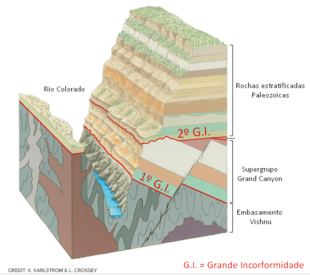
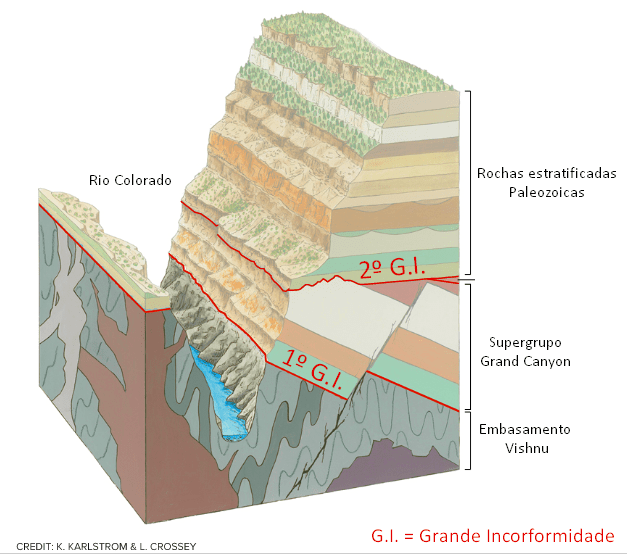


1.7 billion years ago: The beginning of geologic history – crystalline basement rocks
The history of the formation of the rocks that make up the Grand Canyon begins about 1.7 billion years ago (Proterozoic Eon), with the formation of metamorphic rocks (rocks that were modified after their formation, due to changes in pressure and temperature deep in the Earth's crust), with igneous intrusions (the name given when magma or lava enters or cools on top of a previously formed rock).
The name given to this set of rocks is Vishnu Basement, which in geology is called crystalline basement: the oldest rocks that provide the support for sedimentary rocks to be deposited. They were formed when two ancient tectonic plates collided with each other, generating volcanic islands and magmatism. Over time, they were eroded and created a flat surface, where the sedimentary rocks of the Grand Canyon Supergroup, also from the Proterozoic Eon, were deposited.
1.25 billion years ago: The Great Unconformity and formation of the Grand Canyon Supergroup
Between about 1.75 billion and 1.25 billion years ago, the geologic history of the Grand Canyon is lost: erosion has erased the rocks from that period like chapters ripped from a history book: geologists call it “The First Great Unconformity.” This unconformity may amount to ~1.2 billion years of lost rock record, due to erosion or non-deposition.
The story begins again between 1.25 billion and 730 million years ago, when new layers of rock, known as the Grand Canyon Supergroup, formed intermittently. Sediments were washed down to the bottom of prehistoric seas and hardened there, forming layers that include a 1.25-billion-year-old limestone studded with fossils of algae, the oldest life recorded in the canyon.
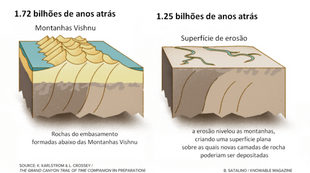
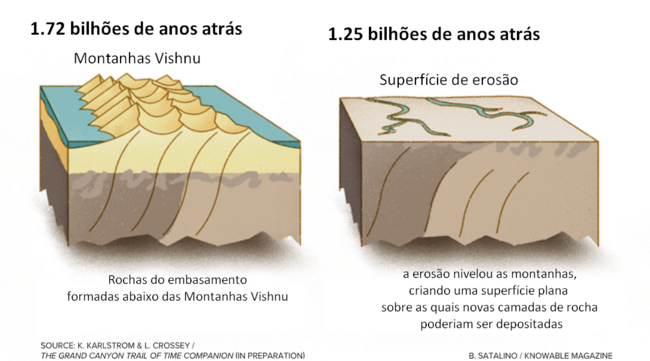


At the time of the deposition of the Grand Canyon Supergroup rocks, approximately 1.2 billion years ago, an ancient supercontinent, Rodinia, was forming. In this process, the continuous uplift and tilting of these layers generated many surfaces of erosional unconformities. Approximately 700 million years ago, Rodinia began to fragment, generating fractures that resulted in the so-called 2nd Great Unconformity, approximately 550 million years ago.
500 million years ago: The horizontal sedimentary rocks of the Paleozoic
Over the next few hundred million years, between about 508 million and 270 million years ago, the horizontally layered rocks that form the upper two-thirds of the canyon walls—the red-colored limestones, shales, and sandstones—were formed. Ocean-fed sediments continued to accumulate, and depositional environments ranging from shallow seas to aeolian terrestrials are recorded in this sequence (generically called the Paleozoic sequence).

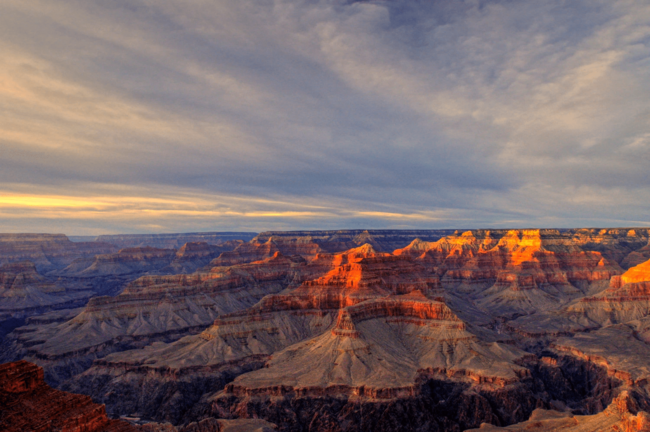


These rocks present a diverse fossil record – they were formed after the so-called “Cambrian Explosion”, a key moment in the diversification of life on Earth: fossils of marine and terrestrial invertebrates, vertebrates and plants, the most common being small marine creatures, such as brachiopods, bryozoans, corals and crinoids, and even shark teeth!
These rocks also record the so-called Great Mass Extinction of the Permian period, about 250 million years ago. At that time, another Supercontinent was formed, Pangea.
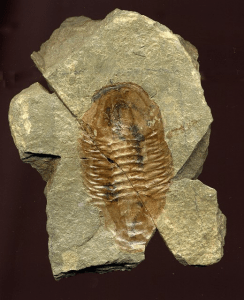



60 million years ago: Colorado Plateau Generation
Then, between 60 and 30 million years ago, the collision and subduction of two tectonic plates, in the Laramide Orogenic event, resulted in the formation of the Rocky Mountains of North America.
During this period, it is believed that the so-called Farallon Plate, an ancient oceanic tectonic plate, was diving onto the North American Plate (subduction process).
This dip or subduction changed over time: instead of the plate subducting at the usual steep angle, the Farallon plate probably subducted at a shallower angle and at a faster rate. This allowed the deformation to move further inland and caused the terrain of the Rocky Mountains and also the Colorado Plateau to rise by a few thousand meters, creating a plateau through which the Colorado River could cut.
This elevation explains why, for example, rocks formed on the ocean floor are today at altitudes of up to 2,700 m – the Kaibab limestone is the uppermost layer of the Grand Canyon and was formed on the ocean floor.
5 million years ago: Colorado River gains strength and carves out Canyon
Finally, the last part of this story, starting “only” 5 to 6 million years ago, the Colorado River began to build up the force to carve its way, carving and shaping the rocks there, leaving the impressive canyon we see today.
Even today, these forces are slowly working, deepening and widening the Grand Canyon – the canyon (landscape) is therefore much younger than the rocks it passes through.
Geologists call the process of canyon formation “downcutting,” and it occurs when a river carves a gorge or valley, cutting through the land and eroding the rocks. Downcutting occurs during flooding.
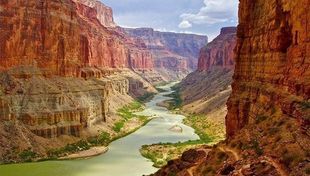
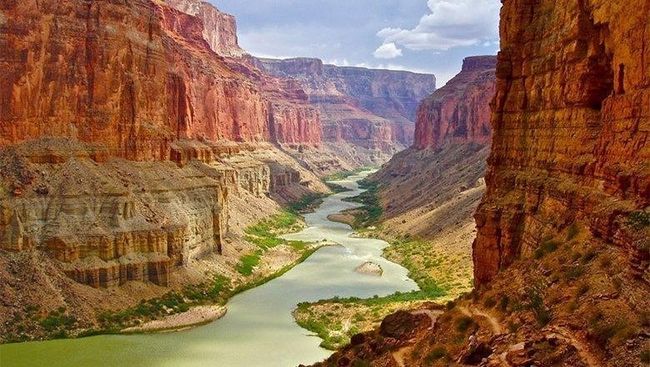


Because the rock layers have different characteristics (mineralogical and textural), they will present different responses (resistance) to erosion processes. Thus, there will be layers that erode more quickly than the hard layers – the result is the distinct step-shaped profile of the Grand Canyon walls that we see today.
Weathering and erosion are ongoing processes and will continue to shape the Grand Canyon over geologic time, even through future tectonic events.
The Grand Canyon truly represents one of the geological wonders of our planet!
Did you like this content? Click here and access more content like this and about various mining topics.
